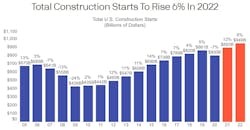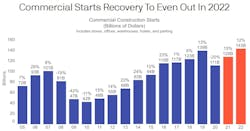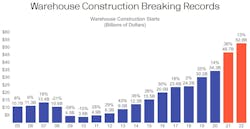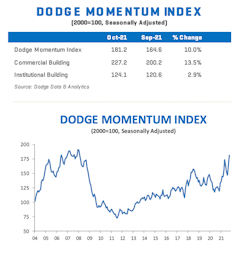Dodge Data Predicts 6% Growth in 2022 Construction Starts
Forecast season officially kicked off last week with the Dodge Construction Network's 83rd annual OUTLOOK conference, attended by more than 500 building products executives and other national players in the design and construction industry. No doubt the pandemic-shaken audience traumaticized by more than a year of economic downturn and uncertainty left encouraged by Dodge's positive predictions for a strong 2022, which kicked off the all-day, online event on Nov. 3.
And that was even before national job gains were announced across the board on Nov. 5, followed by Congress's late night passage of the long-awaited, almost mythical, $1.2-trillion federal infrastructure bill. Its arrival Friday served to validate Wednesday's optimistic data.
"It's a long road back to full recovery for the construction space, but we're expecting a 6% gain in construction starts in 2022, which actually puts us above where we were in 2019," said Richard Branch, chief economist for DCN (formerly Dodge Data & Analytics). "But bear in mind that much of this growth is due to the residential sector. Pull that out, and next year we would still be 3% to 4% below the 2019 level."
Even so, Dodge is now calling for across-the-board growth in most categories next year, still recovering from the pandemic's sudden widespread devastation in 2020.
Specifically, Branch's forecast is predicting 12% growth in commercial construction starts in 2022, anticipated to total $143 billion, which builds on this year's 15% rebound in that category. The sector will likely be led by a still-surging market for warehouse construction, predicted to reach $52.8 billion in new work next year, up 13% from 2021. According to Dodge, the warehouse market has increased ten-fold since 2010, driven most aggressively by Amazon's mammoth, coast-to-coast building program for large fulfillment centers. The giant online retailer, alone, has spent nearly $10 billion on such projects since 2018.
"We do expect that commercial growth will be more broad-based in 2022," said Branch. "Previously it had been heavily reliant on that warehouse growth."
Overall, Dodge is predicting a 10% gain in office construction starts next year, climbing to $49.7 billion in starts and more than doubling the category's 4% rebound this year. Similarly, education and healthcare construction both are forecast to climb 9% in 2022, reaching totals of $67.5 billion and $32.9 billion, respectively.
- For the full Dodge Construction Forecasting, click here.
Looking ahead more broadly, Branch also offered considerable advice for firms trying to navigate a changed world.
"The pandemic has, and will, and will continue to change the shape of how we interact with buildings, offices, healthcare, schools, residential, etc.," he said. "The market is shifting drastically, so make sure that your business plans are flexible enough to stay ahead of those changes as they evolve. "
As the global supply chain now creaks and moans under the unprecedented pressure of worldwide pandemic demands and inadequate shipping and transportation infrastructure, construction firms are advised to build as many contingencies into their plans as possible.
"Materials price increases and shortages will persist into next year and not improve until the back half of 2022," noted Branch. "Also, make sure that you are investing in research and equipment that will improve your productivity. Labor shortages are systemic and they will extend beyond 2022. So, your ability to take on more jobs with fewer people will require investments in technology and new processes."
##########
In an earlier OUTLOOK presentation, Moody's Analytics Deputy Chief Economist Cristian deRitis (pictured below) also noted the welcome effect that new technology has had on productivity. "A silver lining in this pandemic is that businesses have done a lot more investments in terms of I.T., machine learning, artificial intelligence, remote work, all spending that perhaps had been put off for a long time," he said. "They are now bearing fruit in terms of enhanced productivity. Expect to see at least some of that carry forward. Productivity growth is now 2% year over year. Prior to the pandemic, it was around 1%. So I do expect that stick around for awhile and these new investments are going to pay off."
Referencing the looming federal infrastructure package (now a reality), deRitis showed the audience this chart (below) that he has been using and updating for five years now, he said. "Infrastructure spending is at an all-time low vs. GDP," he said. "Some of the supply chain issues we are seeing now are a direct result of underinvestment in those areas. So I do see a very positive picture now for infrastructure spending.... The economy is on a much better footing than it was just a few weeks ago, and certainly a few months ago."
#########
On Nov. 5, Dodge also issued a press release, announcing its latest Dodge Momentum Index, which increased 10% in October to 181.2 (2000=100), up from its revised September reading of 164.6.
The Momentum Index is a monthly measure of the initial report for nonresidential building projects in planning, which have been shown to lead construction spending for nonresidential buildings by a full year. In October, commercial planning rose 14% and institutional gained 3%.
The value of nonresidential building projects entering planning has staged a solid recovery this fall. It has lifted the Momentum Index to its highest level in nearly 14 years, following a near-moribund summer of activity. The commercial sector has shown strength, having reached its highest level since the inception of the Index.
October's gain in the Momentum Index was driven by increased planning in warehouses, offices, and healthcare structures. Compared to a year earlier, the Momentum Index was 47% higher in October 2021. The commercial planning component was 59% higher, and institutional was 26% higher.
"The dollar value of projects in the planning stage is impressive and portends a healthy rise in nonresidential building construction starts on tap for 2022," said Branch. "However, that expectation must be balanced against rising material costs, shortages of key goods, and a lack of skilled labor that will work to keep growth rates modest next year.".
##########
About the Author
Rob McManamy
Editor in Chief
An industry reporter and editor since 1987, McManamy joined HPAC Engineering in September 2017, after three years with BuiltWorlds.com, a Chicago-based media startup focused on tech innovation in the built environment. He has been covering design and construction issues for more than 30 years, having started at Engineering News-Record (ENR) in New York, before becoming its Midwest Bureau Chief in 1990. In 1998, McManamy was named Editor-in-Chief of Design-Build magazine, where he served for four years. He subsequently worked as an editor and freelance writer for Building Design + Construction and Public Works magazines.
A native of Bronx, NY, he is a graduate of both the University of Virginia, and The John Marshall Law School in Chicago.
Contact him at [email protected].





